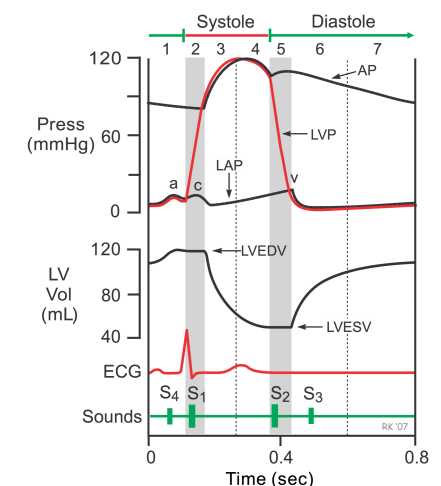- The first phase is initiated by the P wave of the electrocardiogram (ECG), which represents electrical depolarization of the atria.
- Atrial depolarization initiates contraction of the atrial musculature. As the atria contract, the pressure within the atrial chambers increases, which forces more blood flow across the open atrioventricular (AV) valves, leading to a rapid flow of blood into the ventricles. Blood does not flow back into the vena cava because of inertial effects of the venous return and because the wave of contraction through the atria moves toward the AV valve thereby having a "milking effect." However, atrial contraction does produce a small increase in venous pressure that can be noted as the "a-wave" of the left atrial pressure (LAP). Just following the peak of the a-wave is the x-descent.
- Atrial contraction normally accounts for about 10% of left ventricular filling when a person is at rest because most of ventricular filling occurs prior to atrial contraction as blood passively flows from the pulmonary veins, into the left atrium, then into the left ventricle through the open mitral valve.
At high heart rates when there is less time for passive ventricular filling, the atrial contraction may account for up to 40% of ventricular filling. This is sometimes referred to as the "atrial kick." The atrial contribution to ventricular filling varies inversely with duration of ventricular diastole and directly with atrial contractility.
- After atrial contraction is complete, the atrial pressure begins to fall causing a pressure gradient reversal across the AV valves. This causes the valves to float upward (pre-position) before closure. At this time, the ventricular volumes are maximal, which is termed the end-diastolic volume (EDV). The left ventricular EDV (LVEDV), which is typically about 120 ml, represents the ventricular preload and is associated with end-diastolic pressures of 8-12 mmHg and 3-6 mmHg in the left and right ventricles, respectively.
- A heart sound is sometimes noted during atrial contraction (fourth heart sound, S4). This sound is caused by vibration of the ventricular wall during atrial contraction. Generally, it is noted when the ventricle compliance is reduced ("stiff" ventricle) as occurs in ventricular hypertrophy and in many older individuals.
> 023. Isovolumetric Contraction (Phase 2)
